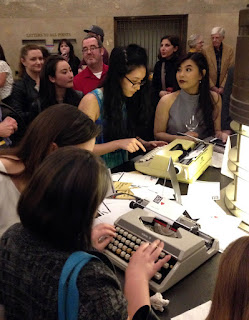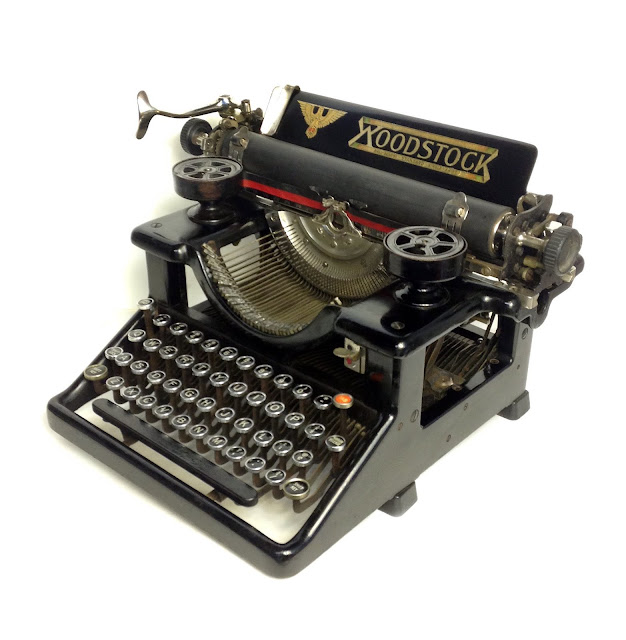Hello, Cleveland!

What brought me the three-and-a-half hours up Interstate 71, a trip that I confess I nearly never take? The opening night of the Cleveland International Film Festival, where "California Typewriter" was the featured film. Readers of this blog are probably aware of the film. In case you're not, here is a trailer that features my manifesto (though I am not the focus of the movie).
California Typewriter Trailer from American Buffalo on Vimeo.
Obviously, being the opening-night film was quite an honor.
The pre-film party was held in a beautiful Art Deco ballroom, where movie-reel-themed table decorations presided over sushi and canapés.


Here I am with director Doug Nichol; Ken Alexander of Berkeley typewriter shop California Typewriter; Toronto typewriter collector Martin Howard; and artist Jeremy Mayer, who turns typewriter parts into amazing sculptures. The film tells the stories of Ken, Martin, and Jeremy, interspersed with interviews with Tom Hanks, Sam Shepard, and others (including me), with many fascinating insights into the meaning, history, and potential of typewriters. It was my first time seeing the completed film, and I found it delightful and uplifting.

The film showed simultaneously in seven well-filled theaters in a cineplex. At the party afterwards, audience members were enthusiastic. Ken was a particular focus of attention.

Martin was invited to "type" on this dress decorated with typewriter keys.

Brian, Kim, and Ian Brumfield of Brumfield & Sons Typewriters attended the film and the party afterwards. Looking sharp!

Naturally, after the film everyone wanted to get their hands on a typewriter. The festival organizers made it possible, with several machines on which people were invited to write "love letters" to the festival. It was great to see people lining up get their turn.












I'm glad to report that the film recently secured an excellent distribution deal. It will be coming to theaters, and will eventually enjoy streaming and other forms of distribution. So you will get a chance to see it before long!
What brought me the three-and-a-half hours up Interstate 71, a trip that I confess I nearly never take? The opening night of the Cleveland International Film Festival, where "California Typewriter" was the featured film. Readers of this blog are probably aware of the film. In case you're not, here is a trailer that features my manifesto (though I am not the focus of the movie).
California Typewriter Trailer from American Buffalo on Vimeo.
Obviously, being the opening-night film was quite an honor.
The pre-film party was held in a beautiful Art Deco ballroom, where movie-reel-themed table decorations presided over sushi and canapés.
Here I am with director Doug Nichol; Ken Alexander of Berkeley typewriter shop California Typewriter; Toronto typewriter collector Martin Howard; and artist Jeremy Mayer, who turns typewriter parts into amazing sculptures. The film tells the stories of Ken, Martin, and Jeremy, interspersed with interviews with Tom Hanks, Sam Shepard, and others (including me), with many fascinating insights into the meaning, history, and potential of typewriters. It was my first time seeing the completed film, and I found it delightful and uplifting.
The film showed simultaneously in seven well-filled theaters in a cineplex. At the party afterwards, audience members were enthusiastic. Ken was a particular focus of attention.
Martin was invited to "type" on this dress decorated with typewriter keys.
Brian, Kim, and Ian Brumfield of Brumfield & Sons Typewriters attended the film and the party afterwards. Looking sharp!

Naturally, after the film everyone wanted to get their hands on a typewriter. The festival organizers made it possible, with several machines on which people were invited to write "love letters" to the festival. It was great to see people lining up get their turn.
I'm glad to report that the film recently secured an excellent distribution deal. It will be coming to theaters, and will eventually enjoy streaming and other forms of distribution. So you will get a chance to see it before long!










